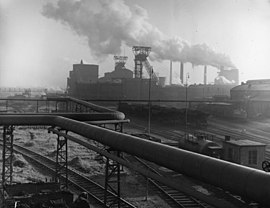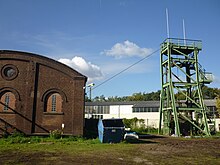Concordia colliery
| Concordia colliery | |||
|---|---|---|---|
| General information about the mine | |||
|
Concordia IV / V colliery in 1959 |
|||
| Funding / year | 1.6 million t | ||
| Information about the mining company | |||
| Start of operation | 1854 | ||
| End of operation | 1968 | ||
| Funded raw materials | |||
| Degradation of | Hard coal | ||
| Geographical location | |||
| Coordinates | 51 ° 28 '25.5 " N , 6 ° 50' 20.4" E | ||
|
|||
| Location | Oberhausen | ||
| local community | Oberhausen | ||
| Independent city ( NUTS3 ) | Oberhausen | ||
| country | State of North Rhine-Westphalia | ||
| Country | Germany | ||
| District | Ruhr area | ||
The Zeche Concordia was a coal - mine in Oberhausen .
history
In 1848 several mine fields in the area of the Lipper Heide were muted by various mining companies . They merged and founded the mining company Concordia (Latin for 'unit') as a stock corporation in 1850 . This was extraordinary insofar as mining companies otherwise operated primarily as trade unions under mining law .
In 1850, the sinking of shaft 1 began near the train station in the Lirich district . This shaft was 1,854 in funding and was a driving skill equipped. A coking plant was built in the immediate vicinity of shaft 1 .
The very low developing in the 1850s boom for coking coal led to the decision, one kilometer west of the shaft 1 to the shaft 2 to be set . This went into production in 1861 and was also equipped with a coking plant . In order to guarantee the high quality of the coal to be coked, a coal washing plant was built for the first time at Shaft 2 in the Ruhr mining industry .
A subsidence caused by the colliery south-east of the Oberhausen train station led to mountain damage occurring from 1868 onwards and the Concordia Lake to form from groundwater around 1870 . This thwarted the development of a city center planned by the mayor of Oberhausen, Friedrich August Schwartz . The colliery participated in the removal of the mountain damage. The lake was drained by a pumping station and a drainage canal. In 1897 a mining director from Concordia AG had the Villa Concordia built there.
The favorable economic development of the colliery led to constant technical development of both mine systems. The driving skills in both shafts were replaced by rope rides in 1876 and 1883 . At the same time, the shafts received Malakow towers with rope pulley frames .
From 1893 to 1895, shaft 3 was sunk next to shaft 2. Furthermore, the company has been pursuing the plan to open up the northern field with an independent conveyor system for a long time.
Between 1899 and 1903, shaft 4 was sunk in Buschhausen , next to which shaft 5 was sunk between 1904 and 1908. Shaft 4/5 received an independent coking plant. At the same time, shaft 1 received a new headframe.
Between 1912 and 1916, a further 1.5 km to the west of the 2/3 shaft was the weather shaft 6, which was designed and equipped as a separate conveyor system, but was 2/3 operationally.
As part of the global economic crisis , it was planned in the early 1930s to shut down Concordia 2/3 after dismantling the fat coal sections. Gradually, however, the decision to expand coal production to 2/3 to the edible and lean coal reserves of the mine field prevailed. For this purpose, shaft 2 was completely filled in and re-sunk with larger dimensions. In 1938 he went into production with a new headframe. At the same time, shaft 1 was filled and discarded after a shaft break .
The colliery survived the Second World War without any significant destruction, so that production could continue without major interruptions in production.
In 1958 it was planned to open up the lean coal reserves in the neighboring, disused Roland colliery . The covered shaft Roland 2 should be repaired again. A headframe had already been erected. However, after the onset of the coal crisis, work was stopped and not resumed.
The production amounted to 1.6 million tons of fat, edible and lean coal annually.
Shutdown
Concordia Bergbau AG had been majority owned by Schering AG for a long time . At the end of the coal crisis of the 1960s, the latter intended to withdraw completely from the coal industry. The Concordia colliery should therefore be closed. Massive public protests meant that the mine should be taken over by the state of North Rhine-Westphalia and other investors. Since these negotiations could not be brought to a conclusion, the colliery had to be shut down in 1968, despite still existing supplies and high productivity.
Current condition
Shafts 2 and 6 are in operation as dewatering shaft systems from Deutsche Steinkohle AG (DSK). The headframes remained in their original construction until the 1990s, after which they were dismantled due to structural defects. Shaft 6 was used at times for drop tests. The buildings in shaft 6 on Niebuhrstrasse are now used as a theater.
The Bero Center and new settlement are also located on the site of the Concordia 2/3 colliery . The site of the Concordia 4/5 colliery has completely merged into the Am Eisenhammer industrial park. Some buildings have been preserved.
As it became known in November 2008, the area of the former Concordia colliery has sagged by more than three and a half meters (in the area of the streets Am Förderturm and Bebelstraße). The competent mining supervisory authority had made a corresponding notification to the District President Arnsberg. The alleged costs of 100,000 euros must be borne by the city of Oberhausen .
literature
- Frank Dittmeyer: Concordia traces . In: Geschichtswerkstatt Oberhausen (Ed.): Shift change - The journal for the history of Oberhausen . Issue 2/07, Oberhausen 2007.
- Andre Wilger, Marion Leschinsky: Industrial history is exposed . In: Geschichtswerkstatt Oberhausen (Ed.): Shift change - The journal for the history of Oberhausen . Issue 1/06, Oberhausen 2006.
- Joachim Huske : The coal mines in the Ruhr area. 3rd edition, self-published by the German Mining Museum, Bochum 2006, ISBN 3-937203-24-9
Individual evidence
Web links
- Description of this sight on the route of industrial culture
- Early documents and newspaper articles about the Concordia colliery in the 20th century press kit of the ZBW - Leibniz Information Center for Economics .



